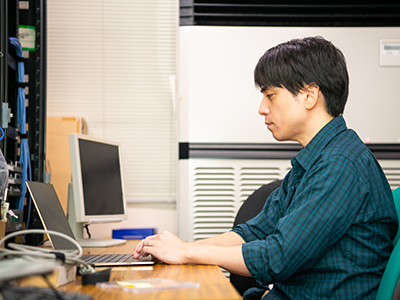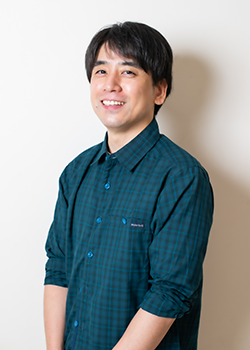Working to Disseminate Bioresource Information with End-Users in Mind
BRC is supported by a diverse staff who are involved in a variety of tasks. We have interviewed staff members from each of the 12 laboratories that make up BRC, asking them about their activities and their day-to-day efforts in their research rooms.
This time, we are speaking with Daiki Usuda, who works in a Technical Staff II position in the Integrated Bioresource Information Division.
He first became interested in programming when he started working on improving the efficiency of information management in another department. Later, he moved to his current department, which manages three programs that utilize RIKEN BRC’s bioresource-related information. We asked him about his thoughts on his work and what he hopes to achieve in the future.
Entering RIKEN BRC through a connection with mice
and pursuing a career in information technology through my work
When I was a student, I majored in ecology and conducted genetic research on wild mice under themes such as “Where do Japanese mice come from?” I was interested in learning about the history of mice, which have always coexisted with people, because I thought this would lead to a better understanding of human history.
I was assigned to work as a temporary staff member at RIKEN BRC because a professor from the laboratory I belonged to when I was a student and the team leader of the department I joined after I joined RIKEN (the current Mouse Phenotype Analysis Division) were in contact with each other through research involving mice. There, in addition to behavioral experiments on mice, I was mainly engaged in hands-on work such as genetic analysis and PCR.
In fact, my current job was partly inspired by my efforts to improve operational efficiency in my previous department. I was also managing data there, but I decided to try to make greater use of information technology in order to improve efficiency. Starting with Excel calculation formulas, I began using programming languages such as R and Python, which make it easier to process data, and as I gradually learned to use them, I became more interested in information technology.
Initially, I began studying programming by myself, but then I gradually began to apply it to my work and created a form that would allow me to work more efficiently. As a result, I became interested in information technology, and the various projects I was working on were proceeding successfully, so when the current director established the Integrated Bioresource Information Division, I happily joined as a technical staff member.
The most rewarding thing is a positive response
Making products with the feelings of users in mind

The Integrated Bioresource Information Division, to which I currently belong, develops information technology to describe and integrate genome information, phenotypic information, application information, and other bioresource-related information in order to widely and effectively utilize bioresources in various research and industrial fields. At the same time, we are responsible for disseminating bioresource information to the world through our website and databases.
This division, which handles information—an essential element for bioresources to function as the basis of science—has members who are highly skilled in information technology in various fields, including web content creation, server and security management, big data analysis and information integration technology in the life sciences.
I am personally involved in developing a system for sharing and utilizing bioresource information internationally and presenting bioresource phenotype data to users in an easy-to-understand manner.
Specifically, we begin by asking each of the divisions to provide us with bioresource data, and then we add to its value by integrating the metadata associated with the bioresource—such as genes, diseases, phenotypes, and environments—with information published by external public organizations, after which we disseminate the information. For example, in the case of genetic information, we utilize the information on gene names, aliases, homologous genes, and related disease information contained in external data. The team’s mission includes the management of data provided by the various development divisions as well as programming to link the data.
I get a sense of satisfaction and accomplishment in my work when I receive positive feedback from the staff of the other development divisions, such as when I handle data from a bioresource web catalog, or when I receive a positive response to my work from related parties or users.
Lately, I have often been asked about services for internal use that we are developing. In my previous division, there was a lot of intra-teamwork and almost no interaction across divisional boundaries. But nowadays I am in contact with people from various other divisions due to the data I receive in the course of my work. We communicate via Slack and various other channels, and we sometimes receive harsh feedback directly from RIKEN BRC’s other laboratories. On occasions when we receive a challenging request to do something better, if we are able to accomplish it, we feel a sense of satisfaction precisely because we know it is not an easy task.
Remembering my favorite saying "Devote oneself body and soul"
I just try to do things with my hands
I am not the type of person who thinks things through carefully and assembles everything before starting work. I like the expression “Devote oneself body and soul to something,” and when I am working on something I want to do, I simply devote myself to the task at hand in precisely that way.
However, I have also experienced some failures that came about because I wanted to do it right away. I once made a mistake in a program that overloaded a server and made it crash, causing problems for the server administrator, and prompting the head of the division to tell me to check the data more carefully in the future. This incident made me realize that up to that point, I had not been seeing the forest for the trees, or to put it another way, I had been so focused on my own work that I had neglected to consider how it might be impacting the smooth and efficient operation of the division as a whole. Since that time, I have become more aware of the overall process, and as a result, the work I am in charge of has been able to meet increasingly demanding standards.

I find my work rewarding every day, but “fun” is something I leave for my private time. A good example would be when I am watching an anime with my 4-year-old daughter, who is obsessed with Pokemon. Doing this sort of thing may also be useful for imagining app user interface development.
In the future, I intend to closely examine what I have learned through my experiences in the field, including any insights gained through responses received from our users, further refine my information technology, and develop a web app that I can publish as my own achievement. In addition, the database infrastructure of my former team has become rather outdated, and a project is underway to revamp it. I will take part in this project, as I know how that team’s database works. This is the team that nurtured me, so I would like to contribute to this project by demonstrating my true “spirit of dedication” and fully utilizing the skills and hands I have cultivated over the years.
Profile
- Daiki Usuda
- Technical Staff II, Integrated Bioresource Information Division
- After working on a different team as a temporary staff member since 2010, he joined the Integrated Bioresource Information Division as a member of the technical staff in 2017. He is currently involved in the development of a system designed to share bioresource information internationally.
Release date : Sep 27, 2024
